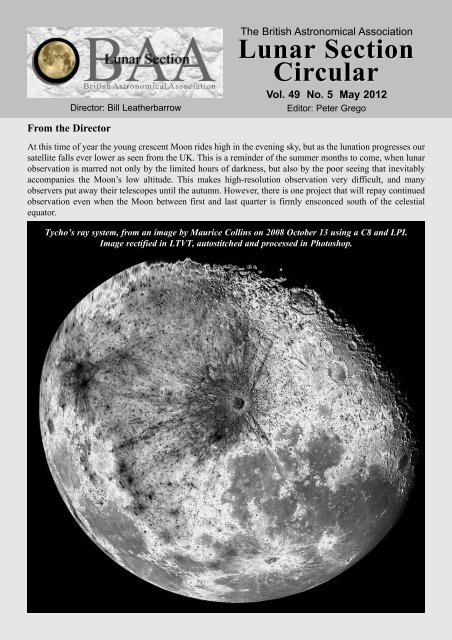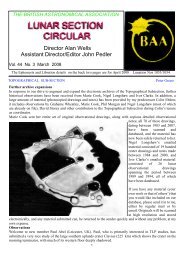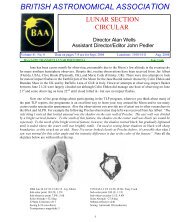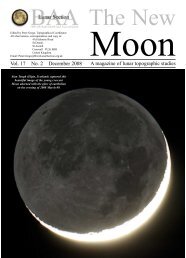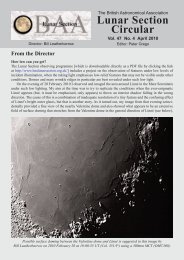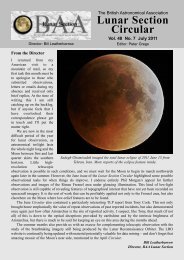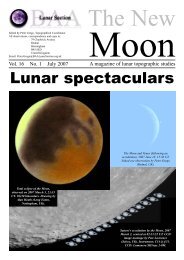Vol 49, No 5, May 2012 - BAA Lunar Section
Vol 49, No 5, May 2012 - BAA Lunar Section
Vol 49, No 5, May 2012 - BAA Lunar Section
Create successful ePaper yourself
Turn your PDF publications into a flip-book with our unique Google optimized e-Paper software.
Director: Bill LeatherbarrowThe British Astronomical Association<strong>Lunar</strong> <strong>Section</strong>Circular<strong>Vol</strong>. <strong>49</strong> <strong>No</strong>. 5 <strong>May</strong> <strong>2012</strong>Editor: Peter GregoFrom the DirectorAt this time of year the young crescent Moon rides high in the evening sky, but as the lunation progresses oursatellite falls ever lower as seen from the UK. This is a reminder of the summer months to come, when lunarobservation is marred not only by the limited hours of darkness, but also by the poor seeing that inevitablyaccompanies the Moon’s low altitude. This makes high-resolution observation very difficult, and manyobservers put away their telescopes until the autumn. However, there is one project that will repay continuedobservation even when the Moon between first and last quarter is firmly ensconced south of the celestialequator.Tycho’s ray system, from an image by Maurice Collins on 2008 October 13 using a C8 and LPI.Image rectified in LTVT, autostitched and processed in Photoshop.
Topographical notescompiled by Peter GregoVisual studies and observationsSince April’s LSC, visual topographic lunar observations have been received (or linked to) from Peter Grego(St Dennis, UK), Chuck Hastorf (Arizona, USA), Philip Jennings (York, UK), Chris Lee (Bristol), PhilMorgan (Tenbury Wells, UK) and Michael Roe (UK). Some of these observations are reproduced below.A note on submitting visual observationsAll visual observations should, in the first instance, be sent to the Director, Bill Leatherbarrow, by regularmail or, as is far more frequently the case these days, as email image attachments (Bill’s address is on the lastpage). If possible, please copy me in on the email with the attachments at editor@baalunarsection.org.uk, asit saves Bill the need to send them on to me for consideration for inclusion in the LSC.Please note that while observations are encouraged to be posted to the <strong>Lunar</strong> <strong>Section</strong> Visual StudiesYahoo! Groups website http://uk.groups.yahoo.com/group/baalunarsection-topography/ it’s important not toregard this as the official <strong>Lunar</strong> <strong>Section</strong> archive or the primary repository for observations. The site is meantto be an adjunct to the main work of the <strong>Lunar</strong> <strong>Section</strong>, and serves as a forum, so please ensure that if you dopost observations there, also to send them to the Director (and me if possible). That way, nobody’s work willbe missed and it will be officially archived, available for comment and analysis.Clarity in labelling image and observation files is important, both to avoid ambiguity and confusion andto make filing, archiving and accessing material easier and more efficient. Ideally, all image files shouldcontain unambiguous date and time data, feature observed, instrument used and observer name. Otherinformation pertaining to the observation, such as colongitude and libration, should be included in thecovering notes, along with a written description (if any) of the observation.EratosthenesObservation byJohn Meacham<strong>2012</strong> February 120:30-21:00 UTSun’s col. 29.3°Seeing: AII125mm MCT, 160x<strong>No</strong>tes: Several bright spotsat central mountain suggesthigh peaks.<strong>BAA</strong> <strong>Lunar</strong> <strong>Section</strong> Circular <strong>Vol</strong>. <strong>49</strong> <strong>No</strong>. 5 <strong>May</strong> <strong>2012</strong> 3
EratosthenesObservation byJohn Meacham<strong>2012</strong> February 1404:45-05:15 UTSun’s col. 170.5°Seeing: AIII. Poor, some haze125mm MCT, 160x<strong>No</strong>tes: The observation wasmade near last quarter. The westends of the Apennine mountainswere in dark shadow, with a fewhigh peaks in sunlight. Thesouth rim of the crater appearedas a gap from the floor out intothe Sinus Aestuum and beyond.The central mountain peakswere prominent.MenelausObservation by Peter Grego(St Dennis, Cornwall, UK)<strong>2012</strong> March 281: 19:45-20:00 UT2: 20:25-20:38 UT3: 21:10-21:22 UT4: 21:40-21:51 UTCol. 1: 342.6-342.7°Col. 2: 342.9-343.1°Col. 3: 343.3-343.4°Col. 4: 343.6-343.7°Seeing: AII, clear, no wind.100mm refractor, 132xIntegrated lightOriginal observational PDA sketchmade freehand (no template used)<strong>No</strong>tes: Sunrise over Menelaus.The sequence was sketched onPDA, the first sketch being madefreehand without a template. Theobservations presented here arethe original PDA sketches; theonlypost-observationenhancement has been to increasethe dpi, remove moiré and includethe relevant text information. Atthe beginning of the observation itwas decided to take in theshadowed area (most of the areacovered by the observationaldrawing) west of Menelaus in41 23 4<strong>BAA</strong> <strong>Lunar</strong> <strong>Section</strong> Circular <strong>Vol</strong>. <strong>49</strong> <strong>No</strong>. 5 <strong>May</strong> <strong>2012</strong>
order to observe and record any high topographical points which might later become illuminated by the risingSun. A watch was kept in order to determine when any features on Menelaus’ floor might first become visible.When the observation was commenced, Menelaus was firmly in shadow; only a sliver of its inner westernwall and a broader crescent of its outer eastern flanks were illuminated by the rising Sun. Initially, thebrightest feature visible was the southern part of Menelaus’ eastern glacis; the inner western wall appearedfar dimmer. However, by the time that the second sketch was made the northern part of the inner western wallhad increased to what appeared a similar brightness to Menelaus’ eastern flanks, and part of the southern rimhad begun to make an appearance. It was obvious, by the time the last observation was made, that the oncebright part of the crater’s eastern flanks had grown dimmer in comparison with the bright portion of the innerwestern wall. The last observation also saw the appearance of a small detached point of illumination withinthe shadow of Menelaus’ interior, not very bright, in the west quite close to the illuminated inner wall. Thefeature was quite obvious and unambiguous, and it was assumed that this must have been one of the crater’sinterior hills. However, on consulting Rükl’s map 23 while writing up these notes is there is no really obviouselevated point in the vicinity of this feature, but it may possibly have been part of the lower inner wallcatching sunlight. The northwestern rim failed to appear. A number of other features around Menelaus, bothwithin Mare Serenitatis and along the Montes Haemus, became visible during the session. <strong>No</strong>table amongthem was unnamed dome north of Menelaus (connected to northern Menelaus by a low ridge), extensions tothe hills and ridges of Montes Haemus near Sulpicius Gallus B (the crater itself was not clearly seen) andridges around Lacus Hiemalis.Arago with domesObservation byPhilip Jennings<strong>2012</strong> March 2819:14-20:30 UTSun’s col. 342.9°Seeing: AIII200mm SCT, 226-339x<strong>BAA</strong> <strong>Lunar</strong> <strong>Section</strong> Circular <strong>Vol</strong>. <strong>49</strong> <strong>No</strong>. 5 <strong>May</strong> <strong>2012</strong> 5
<strong>No</strong>tes: A particularly fine view of the Spitzbergen range at sunrise was enjoyed. Situated some 65 kilometresto the north of the outer northern glacis of Archimedes, the entire range is some 60 kilometres in length, andis probably the remains of a once fine inner Imbrium mountain ring. Despite the fact that none of theindividual peaks attain a height of over 1,500 metres, at both sunrise and sunset some of these cast very finespires of shade, and on this occasion they were seen spreading some 65 kilometres (about 40 miles) to thewest of the range. Just immediately to the west of the Montes Spitzbergen is a fine broad flat-topped wrinkleridge which gently meanders down to the 12 kilometre crater Kirch, and then continues on its northernjourney almost as far as the Mons Pico.6<strong>BAA</strong> <strong>Lunar</strong> <strong>Section</strong> Circular <strong>Vol</strong>. <strong>49</strong> <strong>No</strong>. 5 <strong>May</strong> <strong>2012</strong>
A new lunar resource: The Photographic <strong>Lunar</strong> Album by K.C. PauRafaello LenaI am very impressed with new available photographic lunar album by K.C. Pau, a valuable resource for lunarobservations. K.C. Pau produced 109 plates reporting his telescopic images of high quality. This remarkablealbum provides a compilation of relevant images accessible for the amateur interested in observing the Moonin order to have a solid base for lunar studies. In fact, some of the lunar regions are shown under differentsolar angles allowing the study of many elusive structures, such as elusive rilles and domes.The best thing about this album is the demonstration how amateurs can go about pursuing this type ofobserving activity, exactly what that Pau does on a regular basis since decades. Digital imaging enhancedamateur capabilities demonstrating the utility of CCD-image analysis in the elucidation of lunar domes andtheir properties, providing important geologic information and measurements for their classification. Manyof these excellent images made by Pau have been analyzed allowing the publication of several GLR articlesin professional journals.I was lucky to meet, some years ago, K.C. Pau in Rome talking with him about the projects concerninglunar researches, and the valuable resource represented by a new lunar atlas. Our past activities, made in theGLR group, are really memorable and very meaningful, stimulating further studies and observations of manyelusive features, most of them proposed by Pau. As examples I can mention the rille traversing the largeValentine dome, the smaller northern dome, the elusive rilles near Manilius and Lassel, features identifiedbefore of the high resolution imagery recently taken by probes such as Selene and the LRO!I am glad that K.C. Pau, active amateur astronomer in GLR group, has produced this remarkable resourcewith enough variety of lunar regions to interest any lunar enthusiast. Surely it is the first important result ofa series of upcoming books born, likely, during the productive activities developed in the GLR group withcombined efforts in order to understand the geologic processes occurred in our Moon. I am sure that thisunique principle will allow the publication of further books.Moreover, as the new photographic lunar album by Pau shows, elusive objects must be imaged under veryoblique solar angle, demonstrating how exploring the terminator can still be productive for lunarinvestigations based on telescopic CCD images. The results of the work done by Pau, as the work done bythe GLR group, demonstrate that our moon is a resource to be still explored.The price of the album is as follows: UK: 10GBP + 6 GBP airmail. EU: 12.00 Euro + 7.5 Euroairmail/ US: $16 + $9.5 airmail. Anyone interestedin this valuable lunar resource can email to K.C. Paukcpaulhk@yahoo.com.hkLet me conclude, referring to my compatriotGaetano Filangieri (1784), that “saying thateverything has already been done is the language ofthose who either lack ability or courage.”. Thisprinciple, illustrated in the images presented in thisrecommended valuable album should be theinspiring base and the key for the youngestgeneration of amateur astronomers.Raffaello LenaGLR group founder, editor in chief ofSelenology Todayhttp://digilander.libero.it/glrgroup/Bill Leatherbarrow writes: K.C. Pau has kindlydonated a complimentary copy of his album to the<strong>BAA</strong> <strong>Lunar</strong> <strong>Section</strong>, and I have written back to himexpressing our thanks. It is, as Raffaello says, a finepiece of work (especially taking into account theconditions under which KC works in central HongKong).<strong>BAA</strong> <strong>Lunar</strong> <strong>Section</strong> Circular <strong>Vol</strong>. <strong>49</strong> <strong>No</strong>. 5 <strong>May</strong> <strong>2012</strong>7
Join us at our Yahoo! Group: <strong>Lunar</strong> Topographic Studieshttp://uk.groups.yahoo.com/group/baalunarsection-topography/More lunar observational drawings, includingobservations featured in previous Circulars, can befound on our Yahoo! Group. Membership of thegroup is open to both <strong>BAA</strong> members and nonmembers,and group members can also post theirown notes and lunar observations on the site.8<strong>BAA</strong> <strong>Lunar</strong> <strong>Section</strong> Circular <strong>Vol</strong>. <strong>49</strong> <strong>No</strong>. 5 <strong>May</strong> <strong>2012</strong>
A note on PtolemaeusNigel LongshawFirstly I would like to thank the Director for his kind words in the last circular relating to my examination ofthe ‘ashen light’ in Plato which was published in the March <strong>Lunar</strong> <strong>Section</strong> Circular. As the director rightlypoints out its important not to look too narrowly at the selenographic record, and in particular anomalousobservations from the past, as certain appearances can often be repeated under the most unexpectedcircumstances. Despite our knowledge of the lunar surface, the Moon’s movements and lighting conditions,apparently pinned down by computer programs and mathematical calculations, the Moon can still surpriseeven the most seasoned observer.It is clear from communication I had with Gerald <strong>No</strong>rth, incorporated in my additional note on Plato inthe last Circular, that even though after consulting the relevant data we might think we know what to expectwhen we go to the eyepiece, however the lunar surface often throws up anomalies which were not expected.In this regard it was with interest that I read Tony Cook’s description of an observation of Ptolemaeus inthe last Circular (page 19 note 4). Initially the language used to describe the observation intrigued me. On1970 April 14 the Brazilian astronomer described ‘a kind of glimmering mist lifted and wafted inside theshady hollow of the crater’ under sunset conditions. The ‘repeat lighting’ image by Brendan Shaw showsPtolemaeus completely shadow filled yet the computer modelling carried out by Tony indicates grazingillumination on the crater floor. As Tony rightly says this effect is very reminiscent of those seen in Platounder sunrise and sunset conditions. It is at such times that Phil Morgan and I noted the appearance of an‘ashen light’ on the floor of Plato.Is it possible that a similar lightingeffect manifests itself inPtolemaeus at sunset and was seenby the Brazilian astronomer?The language of description issimilar ‘glimmering mist’, milkylight’ and so forth. The Brazilianastronomer’s description ofapparent movement of thisephemeral light could beexplained by seeing conditions asTony suggests, whatever theexplanation it’s clear thatsomething at the very edge of theastronomer’s vision andinterpretation was seen in 1970.Is it possible that underextreme conditions of sunrise orsunset over certain lunar features,maybe those larger craters with alarge relatively smooth innersurface, surrounded by a relativelyregular rim, we see the lastvestiges of a dim sunlight glow onthe crater’s interior at sunset?LRO image of Ptolemaeus. NASA.Alternatively under sunrise conditions might we also be able to detect the first effects of sunlight bathing thecrater surface before the early shafts of sunlight stream through valleys in the crater wall and focus ourattention with their brilliance. In both cases perhaps under those extreme angles of illumination, without theintensity of ‘direct’ sunlight the boundaries between light and shadow become too diffuse to be resolved byeye and telescope?As Bill indicated, it would certainly be worthwhile keeping a close eye on Plato, and perhaps we nowmight include Ptolemaeus, under extreme conditions of sunrise and sunset in order to see if the phenomenonis repeated without relying too heavily on what we might expect to see from consultation of the ephemeris.<strong>BAA</strong> <strong>Lunar</strong> <strong>Section</strong> Circular <strong>Vol</strong>. <strong>49</strong> <strong>No</strong>. 5 <strong>May</strong> <strong>2012</strong> 9
Observations of the lunar south polar areaMichael RoeThese four sketches were made of the southern cusp in March and April 2011 using a 200mm SCT, 220x, andthey are presented in order of advancing colongitude. The area varies a great deal as libration and lightingangle change. Only a few fragments remain above the blanket of shadow at these colongitudes, makingidentification of features very difficult in this mountainous region.2011 March 6 18:20 UT Col. 292.2° Libration lat. -6.5° Libration long. -1.4°AmundsenLeibnitz Band M6?M52011 March 7 19:00 UT Col. 304.7° Libration lat. -6.2 Libration long. -2.7R6 Amundsen Liebnitz B South pole Mountainssouth ofCabaeusM52011 March 8 18:25 UT Col. 316.5° Libration lat. -5.6° Libration long. -3.9°M6? South pole MountainsLiebnitz B below south of Cabaeus M52011 April 7 20:05 UT Col. 322.9° Libration lat. -2.5° Libration long. -5.9°Boguslawsky Demonax Scott Leibnitz B South pole M5north wall10<strong>BAA</strong> <strong>Lunar</strong> <strong>Section</strong> Circular <strong>Vol</strong>. <strong>49</strong> <strong>No</strong>. 5 <strong>May</strong> <strong>2012</strong>
On the related seeing deformation affecting the gamma peak shadow:a simultaneous and independent surveyRafaello LenaTwo papers appeared in theFigure 1.Journal of <strong>Lunar</strong> & PlanetaryObservers proposed that the hooklikeshadow on the floor of thelunar crater Plato drawn byWilkins and Moore on 1952 April3 (Figure 1, shown at right) isprojected by a complex andelongated hill lying on Plato’sfloor (Favero, Lena, et al, 2000;Favero, Lena, et al, 2001). Toexplain these differences some ofus have suggested that the Englishobservers each executed at thetelescope only a partial drawingintended only to record a fewfeatures on Plato’s floor, includingthe hook-like shadow. In anotherpaper published in JALPO (Lenaet al, 2002) we have carried out asurvey with simultaneous andindependent observations on datesproposed by other observers wherethe hook should be detectable (cf. Lena et al, 2002 and references therein). During the mentioned survey wehave demonstrated that any curvature detectable in our images lasts only small intervals of time and is relatedto seeing-induced deformations. Because of these fluctuations, and no simultaneous and independentconfirmation, curvature in any of the images (displaying a hook) must be considered to be spurious.A new observing session was recently proposed in order to have a confirmation of the Plato hook, whichwas attributable to the Gamma peak shadow. See http://luna.uai.it/index.php/Ombra_nel_cratere_PlatoTo study the possible causes of the aspect of the Gamma Peak’s shadow, several observations were carriedout. In this work I present the result of two images taken exactly at the same time, on <strong>2012</strong> March 1 at 20:33UT, with two independent observations and from two observatories located about 200 km apart. Instrument,data and the two images (by the author of this article and Andrea Tomacelli) are reported in Figure 2 (shownoverleaf). Results confirm that any curvature detectable is related to seeing-induced defocusing anddeformations, confirming the previously conclusion published in JALPO (cf. Lena et al, 2002). Moreoverimages with crisper detail show a straighter shadow. This has broad implications for amateur astronomers inan age when imaging is considered to yield definitive data.Raffaello LenaGLR group founder, editor in chief of Selenology Todayhttp://digilander.libero.it/glrgroup/References:Lena R., Di Iorio G., Bares A., Fattinnanzi C., Favero G. (2002) Plato's Hook, Part III: On the Curvature ofthe Gamma Peak’s Shadow on Plato's Floor, JALPO, vol 44 (4), pp.37-43.Favero G., Lena R., Lottero F., Fiaschi M. (2001) The nature of the hook-like shadow on Plato's floorobserved by Wilkins and Moore in 1952—Part II. Simulations with a computer and a plasticine model.JALPO, 43(3), pp. 24-29.Favero G., Lena R., Mengoli G., Cipolat A., Gualdoni P. (2000) The nature of the hook-like shadow observedby Wilkins and Moore on Plato's floor in 1952. JALPO, 42(3), pp. 126-132.<strong>BAA</strong> <strong>Lunar</strong> <strong>Section</strong> Circular <strong>Vol</strong>. <strong>49</strong> <strong>No</strong>. 5 <strong>May</strong> <strong>2012</strong> 11
Figure 2.12<strong>BAA</strong> <strong>Lunar</strong> <strong>Section</strong> Circular <strong>Vol</strong>. <strong>49</strong> <strong>No</strong>. 5 <strong>May</strong> <strong>2012</strong>
Reinhold and Lansberg by Chris Lee.<strong>BAA</strong> <strong>Lunar</strong> <strong>Section</strong> Circular <strong>Vol</strong>. <strong>49</strong> <strong>No</strong>. 5 <strong>May</strong> <strong>2012</strong> 13
ImagesSince April’s LSC, lunar imges (or links to images) have been received from Maurice Collins (New Zealand),Ed Crandall (USA), David Finnigan (UK), Kevin Kilburn (UK), Richard Hill (USA) and David Scanlan(UK). A selection of these images is featured below. My apologies to those contributors whose hard-won workis not featured in this issue; as usual space considerations mean that only a representative sample of materialis included. Images intended as part of the <strong>Section</strong>’s ongoing investigations into lunar colours should besent to director@baalunarsection.org.uk who will pass them on to Kevin Kilburn. Occasional updates onlunar colour observations will appear in future issues of the LSC.14<strong>BAA</strong> <strong>Lunar</strong> <strong>Section</strong> Circular <strong>Vol</strong>. <strong>49</strong> <strong>No</strong>. 5 <strong>May</strong> <strong>2012</strong>
<strong>BAA</strong> <strong>Lunar</strong> <strong>Section</strong> Circular <strong>Vol</strong>. <strong>49</strong> <strong>No</strong>. 5 <strong>May</strong> <strong>2012</strong> 15
Ed Crandall’s images of the Moon, taken on 2011 December 1 using a 110 mm f6.5 apo, 3x Barlowand Toucam. The image above shows Aristoteles and Eudoxus (23:14 UT), the image below showsAtlas and Hercules (23:16 UT).16<strong>BAA</strong> <strong>Lunar</strong> <strong>Section</strong> Circular <strong>Vol</strong>. <strong>49</strong> <strong>No</strong>. 5 <strong>May</strong> <strong>2012</strong>
Transient lunar phenomena, <strong>May</strong> <strong>2012</strong>Tony CookRoutine observations for March <strong>2012</strong> were received from the following observers: Jay Albert (Lake Worth,FL, USA) observed: Alpetragius, Alphonsus, Aristarchus, Biot, Briggs, Censorinus, Cleostratus,Eratosthenes, Plato, Posidonius, Pythagoras, the South Pole, Schickard, Torricelli B and Tycho. Rolf Carstons(New Zealand) took a whole disk image of the Moon. Maurice Collins (New Zealand) took an image ofCopernicus and whole disk images of the Moon. Marie Cook (Mundesley, UK) observed: Alphonsus,Aristarchus, Bullialdus, Censorinus, Copernicus, Eratosthenes, Hercules, Kunowsky, Messier, Mons Pico,Pico B, Plato, Posidonius, Proclus, Tycho, and Yerkes. I took time lapse video of the Moon and also videodEarthshine, looking for impact flashes from Aberystwyth University (to gain additional footage for myundergraduates). Peter Grego (St Dennis, UK) observed Menelaus. Rolf Hempel (Germany) took a wholedisk image of the Moon. <strong>No</strong>rman Izett (New Zealand) took whole disk images of the Moon. Jim McAloon(New Zealand) observed Aristarchus, and Mare Humorum. Pietre Malinski (Poland) imaged several areas ofthe Moon. Bob O’Connell (Keystone Heights, FL, USA) observed Alphonsus, Aristarchus, Briggs, Manilius,Menelaus, South Pole, and Schickard. Peter Odin (Germany) took a whole disk image of the Moon. BrendanShaw (UK) imaged Aristarchus, Eratosthenes, Plato, Mare Crisium, Torricelli B, Tycho, and several otherfeatures.News: It was interesting to read Nigel Longshaw’s article in the March <strong>BAA</strong> <strong>Lunar</strong> <strong>Section</strong> Circular on asunrise and sunset appearances of the floor of Plato, and how these may explain some TLP reports about thiscrater from the past. I will certainly be updating the weights of many of the past Plato TLP reports in duecourse, and probably even taking some out of the TLP category. But for now, please keep on observing at thetimes given in the predictions web site, because even if some of the original reports are not TLP, by allaccounts they are still spectacular to observe and anyway make useful additions to the routine observationsdatabase that I am using to calibrate the TLP database with.Routine Reports: As usual, space is rather limited to describe all of the routine reports sent in, but here arejust a few highlights from March <strong>2012</strong>:Figure 1 (Left) Maurice Collins’ image from 2008 Jul 7 showing a tiny but very bright dot on the northernshore of Mare Crisium – north is towards the top right. (Right) Brendan Shaw’s image from <strong>2012</strong> Mar 27UT 18:51 with a similar very bright white spot near the top of the image.1) Mare Crisium: On 2008 Jul 07 UT 05:28-08:36 Maurice Collins imaged a very bright spot on the northernshore line of Mare Crisium. As you can see from Figure 1 (above, left) this was appreciably brighter thanother features in the area. We gave this observational report a TLP weighting of 1 originally, because althougha ray crater can be found near the top end of a (45º according to LRO) slope at this location in theConsolidated <strong>Lunar</strong> Atlas, the Kaguya <strong>Lunar</strong> atlas, and also in Apollo and LRO images, it did seem somewhatbrighter than what one might expect from this ray crater alone. I was therefore very interested to see an imageby Brendan Shaw, from about a day later in colongitude that showed a similarly very bright spot here. <strong>No</strong>wthat we have this, and it matches the brilliance, I am happy to eliminate this from the TLP list, even thoughit is not exactly similar illumination. I am also removing Don Spain’s report on a bright spot from 2005 Jan15 (a daylight observation) from the TLP list, and a couple of reports by Peter Andersen from 1980 Mar 20and Apr 21. Malcolm Ellis wrote in a letter to the <strong>BAA</strong> <strong>Lunar</strong> <strong>Section</strong> Circular (1980, p65) that this spot is atits brightest between colongitudes of 310º-350º, with it peaking in brightness at 320º. He also commented that<strong>BAA</strong> <strong>Lunar</strong> <strong>Section</strong> Circular <strong>Vol</strong>. <strong>49</strong> <strong>No</strong>. 5 <strong>May</strong> <strong>2012</strong> 17
it is the brightest spot on the Moonup until nearly first quarter. Soalthough not regarded as a TLPsite any longer, observers mightwant to keep an eye open for thisfeature to test out the claims that itcan appear to be one of thebrightest points on the Moon, for acertain set of phases. I guess thatdoing a brightness threshold ondigital images would be a goodtest to see how it ranks withProclus and Censorinus in termsof brilliance.Figure 2. Prinz by Piotr Malinksitaken on <strong>2012</strong> Mar 04 at UT19:30 with north at the top.2) Prinz: On 1975 Feb 22 UT19:00-22:50 Peter Foley, using a30cm reflector (seeing good)observed Prinz to have a diffusewhite obscuration with pulsationsof 30-50 sec intervals. The effectfaded and had ceased by 22:50. Photographs were taken but showed nothing unusual, and no colour was seen.On <strong>2012</strong> Mar 04 UT Piotr Malinksi took some high resolution images of the Moon; one of them covered Prinzcrater and can be seen in Figure 2 (above). This clearly shows no sign of anything that might have resembledan obscuration. Therefore the weight for the Foley TLP observation will remain at 2; not quite making it to a3 because the photographs taken at the time did not reveal anything, but of course old fashioned photographicresolution was always worse than visual resolution.3) Kunowsky: On 1964 Sep 22 UT 03:25-04:30 Gilheany, Hall and Johnson (Port Tobacco, MD, USA,),using a 40 cm reflector, under good seeing conditions, detected a red area in this 18 km diameter crater (SWof Copernicus), using a Trident electronic Moon Blink device. Marie Cook checked out the crater under thesame illumination conditions on <strong>2012</strong> Mar 8 UT 22:05-22:15, and found that the crater looked brighter in ared filter too, although she was using a smaller 90mm Questar telescope (seeing Antoniadi III, transparencymoderate to poor). I have checked the Clementine UVVIS Multispectral Mosaic on Map-a-Planet Explorer(http://www.mapaplanet.org ) but cannot find a natural reddish colour to this crater, so maybe it is an effectspecific to this phase angle? Kunowsky would certainly be in interesting challenge for colour imagingenthusiasts within the <strong>Lunar</strong> <strong>Section</strong>!4) Briggs. On 2010 Apr 27 UT 00:10-00:30 and 01:45-02:00 Peter Grego (20 and 30 cm reflectors) sketchedBriggs and found a craterlet to the east that did not appear on the NASA LAC chart of this area, and therewas also an E-W curvilinear marking coming off this crater to the east (see Figure 3 overleaf). Brendan Shawin March 2011 re-imaged the area and confirmed the craterlet did exist, but that there was no sign of the E-W marking. Jay Albert and Bob O’Connell re-observed visually under similar illumination conditions on<strong>2012</strong> Mar 06. Jay used a 28 cm SCT with transparency at 4th magnitude and seeing varying from (4-6)/10.Jay observed from 03:50-04:20 UT at 311x and reported: “The tiny craterlet close to and E of Briggs waseasy to see, even when the seeing deteriorated to 4/10. This tiny craterlet is E of the N-S wrinkle ridgebordering Briggs to the E and N of the two larger craterlets SE of Briggs. The latter two craterlets are shownon chart 17 of Rukl, but the tiny craterlet is not. I could not detect an “E-W trending lineament or wrinkle18<strong>BAA</strong> <strong>Lunar</strong> <strong>Section</strong> Circular <strong>Vol</strong>. <strong>49</strong> <strong>No</strong>. 5 <strong>May</strong> <strong>2012</strong>
idge”. I could plainly see the ejecta ray running NE from Seleucus, but no wrinkle ridge. There were acouple of low hills lined up to the E of the tiny craterlet, but they weren’t connected and didn’t form a ridge.Briggs itself was just beyond the terminator with only its exterior E wall rising out of the shadow. Bobobserved at 04:20-04:26 UT in white light using a 23 cm SCT, with a 160x binoviewer (seeing 3/10). He sawthe eastern rim of Briggs on the terminator and detected the craterlet just to the east of Briggs, but like Jay,did not see the E-W trending lineament. Bob captured an image earlier at 03:29UT and this can be seen inFigure 4, again no sign of the E-W lineament. So the issue concerning Peter Grego’s original observation isnot the craterlet failing to be present on maps (it does appear on <strong>Lunar</strong> Orbiter imagery from the 1960s), butwhy does the E-W lineament not show again? I am raising the weight of this TLP report from a 1 to a 2. Let’skeep on looking, trying to get higher resolution imagery at sunrise over this area to see if we can fathom outwhat was seen?Figure 3. Peter Grego’s PDA sketch of Briggs (rectified to match the LAC chart at right) from 2010 Apr 27with north at the top.Figure 4. (Left) Bob O’Connell’s image of Briggs from <strong>2012</strong> Mar 06. (Right) Same image but afterundergoing high pass filtering (radius 9 pixels) to remove large scale brightness trends. The dark shadingeither side of Briggs is an artefact of image enhancement. <strong>No</strong>rth is towards the top.TLP Reports: One TLP report was received during March. On <strong>2012</strong> Mar 28 Peter Grego was making somePDA sketches of Menelaus at sunrise using a 10 cm refractor at x132 (Seeing Antoniadi II). All seemed to bea normal sequence in the four sketches made at: 19:45-20:00, 20:25-20:38, 21:10-21:22, and 21:40-21:51 UT,except that upon checking up later on the last sketch (Figure 5e), Peter noticed an illuminated patch just inside<strong>BAA</strong> <strong>Lunar</strong> <strong>Section</strong> Circular <strong>Vol</strong>. <strong>49</strong> <strong>No</strong>. 5 <strong>May</strong> <strong>2012</strong> 19
the western rim, that does not show up in the previous sketch (Figure 5d) or on other images taken earlier thatnight of sunrise over the crater (Figure 5a-c). Bill Leatherbarrow found an image from a higher sun angle thatshows something closer to the floor (Figure 5h), however computer simulations with ALVIS do not replicatethe illuminated patch at the time of Peter’s sketch (Figure 5f), or even allowing illumination from over theentire half a degree angular diameter of the solar disk (Figure 5g). A check on NASA’s LRO LOLAtopographic dataset sSee Figure 6) shows no obvious terrace on the inner crater wall. So therefore I amtherefore assigning a weight of 3 to this report for now, until we obtain some imagery closer to the sameillumination and can determine if perhaps the illuminated spot is due to something like scattered light fromthe lit part of the crater lighting up some bright albedo marking in the shadow?Figure 5. The above images, sketches and simulations all have north towards the top and are from <strong>2012</strong>Mar 28 unless specified otherwise. (a) Image by Brendan Shaw from 17:55 UT (Col.=341.8º). (b) Image byRolf Hempel from 18:59 UT (Col=342.3º). (c) Image by Peter Odin from 19:37 UT (Col.=342.6º) (d) PDAsketch by Peter Grego from 21:10-21:22 UT (Col.=343.5º). (e) PDA sketch by Peter Grego from 21:40-21:51 UT (Col.=343.7º). (f) ALVIS simulation for 21:46 UT (Col.=343.7º). (g) ALVIS simulation for 22:46UT (Col.=344.2º) or 0.5º later to take into account the angular diameter of the solar disk. (h) Image by BillLeatherbarrow from 2009 Apr 01 UT 18:58 (Col.=350.0).Figure 6. Topographic cross-sectional profile through Menelaus from East to West using ACT-REACTQuickMap available on the LROC web site: http://target.lroc.asu.edu/da/qmap.html20<strong>BAA</strong> <strong>Lunar</strong> <strong>Section</strong> Circular <strong>Vol</strong>. <strong>49</strong> <strong>No</strong>. 5 <strong>May</strong> <strong>2012</strong>
Suggested Features to observe in <strong>May</strong>: For those of you without access to the internet (in the UK), belowis a list of repeat conditions for when a feature will exhibit the same illumination and libration as was seenfor a historical TLP observation from the past. By re-observing and submitting your observations, we will geta clear understanding of what the feature ought to have looked like at the time. Only this way can we reallyfully analyze past TLP reports.<strong>2012</strong>-<strong>May</strong>-01 UT 19:29-19:50 Ill=75% Hevelius observed by Emmett on 1826-04-17: Please image orsketch.<strong>2012</strong>-<strong>May</strong>-02 UT 19:31-20:39 Ill=85% Torricelli B observed by <strong>No</strong>rth on 1995-04-11: Can you see orimage any colour on the crater and how bright or dull is the crater?<strong>2012</strong>-<strong>May</strong>-02/03 UT 21:05-00:51 Ill=85% Promontorium Laplace observed by Beraud on 1970-08-13:Almost certainly jest a shadow off the very steep peak, but please verify.<strong>2012</strong>-<strong>May</strong>-03 UT 19:32-20:40 Ill=93% Aristarchus observed by Foley on 1975-02-23: Any colour seen anddoes this change over time?<strong>2012</strong>-<strong>May</strong>-14 UT 02:08-04:19 Ill=38% Aristarchus observed by Sekiyuchi 1970-07-26: Please image orsketch.<strong>2012</strong>-<strong>May</strong>-16 UT 02:44-03:08 Ill=20% Elger observed by Merosi on 1970-08-27: Can you see this inEarthshine and does the crater change in brightness as the seeing or transparency varies?<strong>2012</strong>-<strong>May</strong>-26 UT 21:00-21:30 Ill=30% Please check Earthshine for sporadic meteor impact flashes.<strong>2012</strong>-<strong>May</strong>-27 UT 21:02-21:54 Ill=40% Please check Earthshine for sporadic meteor impact flashes.<strong>2012</strong>-<strong>May</strong>-30 UT 20:12-23:24 Ill=72% Archimedes observed by Miranda on 1971-08-01: Can you see twogrooves or rays going from east to west, broadening towards the west?For repeat illumination (only) TLP predictions for the coming month, these can be found on the followingweb site: http://users.aber.ac.uk/atc/tlp/tlp.htm .For members who do not have access to the internet, pleasedrop me a line and I will post predictions to you. If you would like to join the TLP telephone alert team, pleaselet me know your phone <strong>No</strong>. and how late you wish to be contacted. If in the unlikely event you see a TLP,please give me a call on my cell phone: +44 (0)798 505 5681 and I will alert other observers. <strong>No</strong>te whentelephoning from outside the UK you must not use the (0). When phoning from within the UK please do notuse the +44! Twitter TLP alerts can be accessed on http://twitter.com/lunarnaut.Dr Anthony Cook, Institute of Mathematical and Physical Sciences, University of Wales Aberystwyth,Penglais, Aberystwyth, Ceredigion, SY23 3BZ, Wales, United Kingdom.Email: atc @ aber.ac.uk.<strong>BAA</strong> <strong>Lunar</strong> <strong>Section</strong> Circular <strong>Vol</strong>. <strong>49</strong> <strong>No</strong>. 5 <strong>May</strong> <strong>2012</strong> 21
Occultation news, <strong>May</strong> <strong>2012</strong>Tim HaymesGraze occultations. R. Emery (Leeds) requested track information for the Zeta Tauri graze on April 25(<strong>BAA</strong>H <strong>2012</strong>, entry 6).This was expected to be best graze event of <strong>2012</strong>. Jupiter will graze the Moon on July15, 02h. Jean Meeus provided data on the track and satellite phenomena in February’s <strong>BAA</strong> Journal, page 31.There is a pdf in the public domain here: http://www.shindles.co.uk/ouastro/jup-occult-meeus.pdfDouble star video. This project aims to detect new doubles, or confirm existing doubles using videotechniques. Observations are needed to increase the success rate. The details of the analysis are bit tricky, butthe important aspect is to record lunar occultations by video and report them to the co-ordinator who can dosome preliminary analysis. The data is then sent to IOTA for comparison with other observers results of thesame star at a diffent lunar position angle. If you have access to one of the many video cameras now available(Mintron, Watec etc) then you can contribute. I have details of the observation techniques involved. Contactme for a copy.Occultations are listed here for Birmingham. Observers elsewhere will need to adjust the prediction by severalminutes. I can produce predictions for any location. Contact me if you would like a set.Occultations Co-ordinator: Tim Haymes, Hill Rise, Knowl Hill Common, Reading, RG10 9YD.occultation@baalunarsection.org.ukCloud Watch observations for March <strong>2012</strong>Andrew BytnarObserver and location Excellent Cloudy Overcast Hazy <strong>No</strong> watchdays days days days daysP.Burt (Chatham) 16 (52%) 1 (3%) 11 (35%) 2 (6%) 1 (3%)A.Bytnar (Mansfield) 13 (42%) 1 (3%) 16 (52%) 1 (3%) -----M.Cook (Cromer) 1 (3%) 14 (45%) 12 (39%) 4 (13%) -----K.Hall (Warrington) 9½ (31%) 7 (23%) 12½ (40%) 2 (6%) -----A.Heath (<strong>No</strong>ttingham) 14 (45%) 8 (26%) 8 (26%) 1 (3%) -----J.Wrigley (Reading) 7 (23%) 10 (32%) 11 (35%) 3 (10%) -----Cloud Watch observations to: Andrew Bytnar, 20 Mansfield Road, Sutton-in-Ashfield, NG17 4EJ.ASByt@sky.com22<strong>BAA</strong> <strong>Lunar</strong> <strong>Section</strong> Circular <strong>Vol</strong>. <strong>49</strong> <strong>No</strong>. 5 <strong>May</strong> <strong>2012</strong>
<strong>Lunar</strong> librations for <strong>May</strong> <strong>2012</strong> (from a program by J.M.H. Hill)<strong>BAA</strong> <strong>Lunar</strong> <strong>Section</strong> Circular <strong>Vol</strong>. <strong>49</strong> <strong>No</strong>. 5 <strong>May</strong> <strong>2012</strong> 23
<strong>Lunar</strong> data for <strong>May</strong> <strong>2012</strong>, lunations 1105/1106 (from a program by Gareth Williams)24<strong>BAA</strong> <strong>Lunar</strong> <strong>Section</strong> ContactsDirectorBill Leatherbarrowdirector@baalunarsection.org.ukAssistant DirectorsTony Cook (with responsibility for TLP work)tlp@baalunarsection.org.ukPeter Grego (Circulars Editor)editor@baalunarsection.org.ukCommittee MembersTim Haymes (Occultations)occultation@baalunarsection.org.ukRobert Garfinkle (Historical Consultant)history@baalunarsection.org.ukBruce Kingsley (Imaging Consultant)photography@baalunarsection.org.ukNigel LongshawBrendan Shaw (Archivist)archives@baalunarsection.org.ukComputing Consultant (position vacant)compute@baalunarsection.org.ukTo receive B&W printed copies of the <strong>Lunar</strong> <strong>Section</strong>Circular, please send a supply of stamped addressedenvelopes to the <strong>Lunar</strong> <strong>Section</strong> Director. Envelopes atleast 11 x 22 cm will ensure no damage in transit.Members who have Internet access may receive theirCirculars (colour version) in PDF format by email(please contact the Director) or by downloading themdirectly from the <strong>BAA</strong> <strong>Lunar</strong> <strong>Section</strong> website athttp://www.baalunarsection.org.uk/circulars.htm.<strong>BAA</strong> <strong>Lunar</strong> <strong>Section</strong> Director: Bill Leatherbarrow,9 Stumperlowe Avenue, Sheffield, S10 3QN, UK.Email: director@baalunarsection.org.ukObservations and items related to a specific area oflunar study should be sent to the appropriate memberof the <strong>BAA</strong> <strong>Lunar</strong> <strong>Section</strong> Committee, but send anymaterial of a more general nature to the Editor.Deadline for items for the June <strong>2012</strong><strong>Lunar</strong> <strong>Section</strong> Circular:15 <strong>May</strong> <strong>2012</strong>Circulars Editor: Peter Grego, 7 Parc-An-Bre Drive,St Dennis, St Austell, Cornwall, PL26 8AS, UK.Email: editor@baalunarsection.org.uk<strong>BAA</strong> <strong>Lunar</strong> <strong>Section</strong> Circular <strong>Vol</strong>. <strong>49</strong> <strong>No</strong>. 5 <strong>May</strong> <strong>2012</strong>


